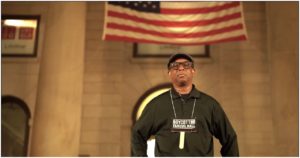In a rare anime anthology series, Tatsuki Fujimoto 17-26 made its world debut at the Global Film Festival. It allowed fans to see several of Tatsuki Fujimoto’s early works from his mangaka career, such as A Couple Clucking Chickens Were Still Kickin’ in the Schoolyard and Love is Blind, and see a different side of the mangaka who is renowned for his work on Chainsaw Man.
Anime Trending had the opportunity to talk with A Couple Clucking Chickens Were Still Kickin’ in the Schoolyard’s director Seishiro Nagaya, Love Is Blind’s director Nobuyuki Takeuchi, and producer Ryo Oyama about what it was like to turn Fujimoto’s one-shots into an anime anthology adaptation series for everyone to see on screen.
This interview was conducted via interpreter and has been edited for clarity. Questions by Anime Trending submitted by Gerrymelyn Casupang, Melvyn Tan, and Isabelle Lee.
Director Nagaya and Director Takeuchi’s thoughts on Fujimoto-sensei’s early works and creating an anime film adaptation
What was your first exposure to Fujimoto-sensei’s work like?
Seishiro Nagaya: It was an unconventional story, but in a good way. When you’re reading Jump for example, you sometimes encounter extremely talented artists. I immediately thought, “This creator is one of them.”
Nobuyuki Takeuchi: Of course, [Love is Blind] is about a love confession, but the impression didn’t come all at once — I gradually realized the details of the story. First, I thought, “Ah! So it’s this type of story,” but then I started to think, “Wait, these two protagonists are standing for a long time. There isn’t a lot of movement, like walking or running. They’re standing in the same spot.” Then I realized they were actually waiting for the rain to clear. While it was raining, an old man robber and an alien came. I kept wondering what the meaning of this was, and I thought, “This is a weird manga.”
In the beginning, I received this manga and started to read this particular episode. After that, I read the other stories, and then I realized, “Okay, so this is the only story with no eating humans and no sex.” It’s actually the only story that’s very pure. So I thought I would also have to relate to this work to give the story a pure feeling.
If you read the original manga, you’ll probably realize that the characters’ eyebrows are always going up, not round. Their facial expressions don’t change at all. Also, the posture they are standing in is very straight. Again, I read other stories and checked on the character’s expressions, and I couldn’t find this anywhere else. So this was obviously an intentional choice for Fujimoto-sensei for these characters. I thought I should keep that in mind.
©藤本タツキ/集英社・「藤本タツキ 17-26」製作委員会
Nagaya-san, what were your thoughts on the original one-shot A Couple Clucking Chickens Were Still Kickin’ in the Schoolyard?
Seishiro Nagaya: In Japanese animation and manga scenes, cool-looking characters are more popular. In Fujimoto-san’s debut work, he drew a lot of weird-looking alien characters. Although there is one human, Ami, who is cute. In other manga, there are always a lot of cool-looking characters and cute-looking characters. But as an animator myself, I prefer drawing weird-looking characters, so, I thought, if this person likes drawing weird characters, then I might be able to relate to him!
Takeuchi-san, you mentioned your first exposure to Love Is Blind already, but was it your first time being exposed to Fujimoto-sensei’s work?
Nobuyuki Takeuchi: This is really my first time. Nowadays, I rarely read manga. I used to read them when I was a child.
Was there any aspect of the story that made you think, “This would be tricky to adapt into an anime?”
Seishiro Nagaya: The key to this animated movie is to display aliens as human-like, but it’s very difficult to portray the daily life of people in any animation. It’s normally more difficult than action scenes. So, especially with aliens, I knew that was going to be hard.
Actually, I sent letters with notes and questions to Fujimoto-sensei. I sent around 20 questions about some particular elements in the story. He answered back, saying, “I don’t remember at all.” (laughs)
I wasn’t sure if he was just saying that or if he truly didn’t remember. Maybe because it was his debut work and the characters were from more than 10 years ago, he actually doesn’t remember at all. Either way, I wasn’t sure what to do with no answers. I felt responsible because this is Fujimoto-sensei’s debut work, and he has a huge fan base. But since he doesn’t remember [the details] at all, most of the things were dependent on my own interpretation.
Nobuyuki Takeuchi: Instead of changing the original content, I had to include some elements that I thought were important, but I didn’t want to change the angle or expressions of the original manga art. So I ended up adding some elements at the beginning and also at the end, like the whale scene.
©藤本タツキ/集英社・「藤本タツキ 17-26」製作委員会
Which scenes are you most proud of? Were there any scenes that were most challenging to create?
Seishiro Nagaya: There’s a scene where Masatoshi transforms, breaks through a window, and jumps from a building. That actually was work from a special animator. If you look closely, you can probably see that the animation in this scene is only done by hand. You can’t achieve that with computer graphics. Almost all animation is [still] drawn by hand, either on paper or a tablet, but I was really adamant about this animation being hand-drawn only. If you could enjoy that part, I would appreciate it.
Can you share who this animator was with the window scene?
Seishiro Nagaya: It was Yasunori Miyazawa. There are many other great animators participating as well.
Takeuchi-san, which scenes were you most proud of and which were most challenging?
Nobuyuki Takeuchi: I cannot say I’m proud of any of my work, but like Nagaya-san, I really appreciate all my staff members, especially Tomoko Mori. She worked on the character animation. The person who worked on the background, Chieko Nakamura — within six months or so, she did close to 300 cuts. It was a lot of work. Those were outstanding. Also, the studio, Lapin Track, did a great job. Normally, toward the end of production, it’s really busy, but everybody worked hard and showed huge commitment. I really appreciate it.
Can you tell us about the drummer? I heard you had an interesting story about that.
Nobuyuki Takeuchi: The music composer is Yuma Yamaguchi, and I requested music with percussion. There are, of course, many different kinds of percussion instruments, and the image that he actually narrowed down was not just any percussion, but the sound of drums and marimba. The drummer listened to Yuma-san’s demos, arranged them, and performed them. Yuma-san brought in someone known as the best drummer in Japan’s music scene!
©藤本タツキ/集英社・「藤本タツキ 17-26」製作委員会
Producer Oyama on producing Fujimoto-sensei’s early works as an anthology series
When producing this anthology, did you have any discussions with Fujimoto-sensei about his vision? If so, what was the process like in bringing his short stories to life?
Ryo Oyama: For this particular anthology, I never talked to Fujimoto-sensei directly. We sent a pitching document to his publisher, the publisher spoke with us, and we got the green light.
Tatsuki Fujimoto 17-26 is coming after Chainsaw Man and Look Back‘s adaptation. When and how did the thought of “it’s time to propose this adaptation of these short stories” materialize?
Ryo Oyama: During the planning and production of Look Back, which was in 2022, I thought that I wanted to produce an anthology of Fujimoto’s work as well. We started talking in the fall or winter of that year.
What do you think this anthology’s role will be in shaping the broader appreciation of Fujimoto-sensei’s work?
Ryo Oyama: This [includes] his earlier works, relatively unknown compared to Chainsaw Man and Look Back. So the fans of Chainsaw Man and Look Back will probably have a chance to take a look at his past works from this anthology, and they will get to know more about the versatility of his talent. At the same time, there are some mutual themes, characters, or styles from the early work as well. There are many different ways to enjoy this, and you can appreciate that.
Could you talk about why Prime Video was chosen and involved as the streaming partner for the anthology?
Ryo Oyama: There are three reasons. First, during the development of this anthology, we knew that this was actually a story of eight one-shots. So each story’s length should be varied. Streaming has more freedom in terms of the total length, so [we thought it would] probably fit better. Also, Fujimoto-san is already famous all over the world, so if we can release it at the same time to the world, it would work better. Finally, we already had a relationship with Prime Video for Look Back, so we wanted to continue that partnership.
We would like to thank Nagaya-san, Takeuchi-san, and Oyama-san for taking the time to talk to us about the anthology series and the episodes they worked on.
Tatsuki Fujimoto 17-26 will premiere on Prime Video on November 7, 2025.






